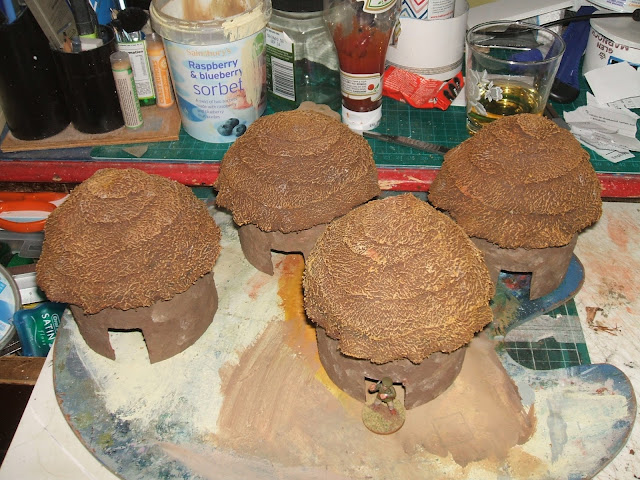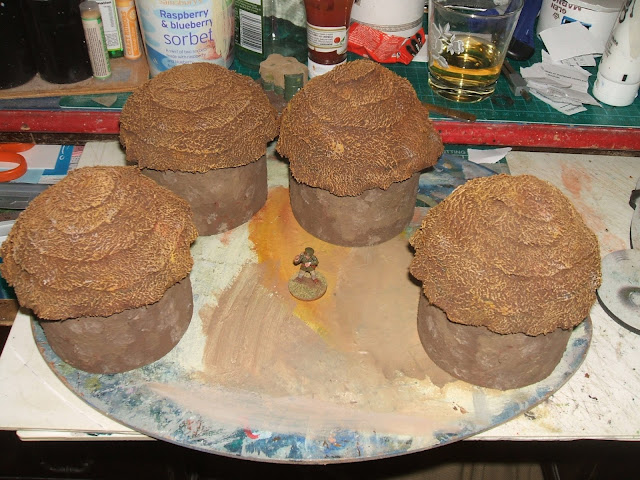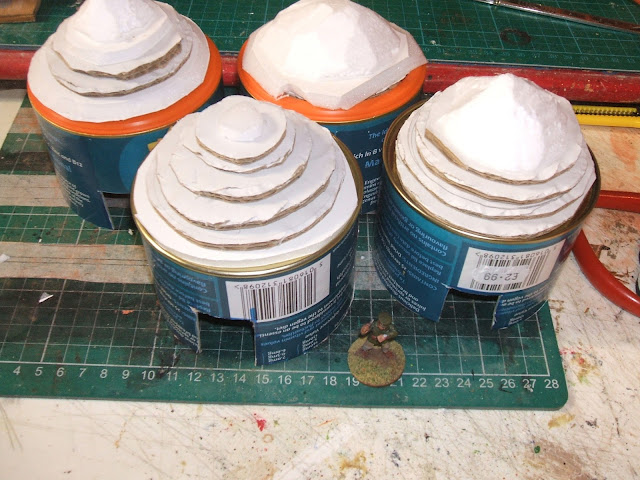I've a lot of stuff on the boil at the minute in terms of fields. I was inspired by Mel the Terrain Tutor's tutorials on fields, and have several square feet under construction. Comprehensive photos will follow in due time, but for now, here's a preview.
Wednesday 18 January 2017
Monday 16 January 2017
Retro Monday #8: Trojan!
A very early vehicle for this blog here. A scratchbuilt/kitbashed open-topped Imperial Guard Trojan, from back when this blog was young, and actually all about AFVs for my now dusty Imperial Guard army. Hard to believe it's from 2010.
Labels:
28mm,
Imperial Guard (GW),
Retro Mondays,
Scratchbuilding
Saturday 14 January 2017
Continuing experiments with Granny Grating brickwork
Bricks and mortar
Right, if you've seen the last blog, you'll know I was pretty happy with how the faux-brickwork came out in terms of its shape. So I continued my work. Brickwork always seems to be to be a range of shades. I suppose I must see a lot of recycled bricks. Anyway, I pulled out black, brown, burnt sienna, yellow and red paints, added a little water, and painted some straight onto the bricks, and adulterated some, too. Some got a rich application of colour, and others a more dilute, wash-like one. I then quickly mixed some filler with a little black paint, and began applying it between the bricks as "mortar". It soon became clear that this was too much hassle, and I painted it over the lot with a brush, then dipped my finger in water, and ran it over the bricks, restoring to them some of their original colour.The benefits of using terracotta clay as opposed to white
There's an interesting point here. Well, interesting for terrain fans. I didn't give the paint on the faces of the "bricks" much time to dry. So when I rubbed off the wash, I am pretty sure I rubbed off some of the paint, too. Here's the thing: I think that actually worked quite well. You see, now I had a wall with bricks in various tones, but all of them showing some of the terracotta Das clay beneath them. It unified the colours. Even better, if it is damaged, it won't show a clean white, but will very closely resemble actual, honest-to-goodness broken brickwork.Greens and browns
Of course, when the filler dried, it became apparent that a) it had got everywhere, dusting up all of the piece, and b) it was too bright. But that's fine. This is a piece explicitly set aside for experimenting. So I tried washing it with a bit of brown, which made very little difference. For reference, filler is hungry for paint, so you'll need to apply more than you think. I then had a walk around my home to get a look at differences in the brickwork. A great thing I noticed was an area which gets a lot of water and little sun, and has lichen or whatever growing all over the brickwork. I washed some sap green over the bricks in the middle of the wall, and pretty much perfectly recreated the reality of the bricks.Warmth is clean
As an aside, if you're thinking about doing that, I also paid attention to the brickwork that is at the back of our cooker. It is a lot cleaner because there's no moisture for the lichen to use. While our chimneys are internal (very internal in one case, since a bit of one came down the chimney into the living room the other day!) I would imagine that the brickwork of external chimney stacks will resemble that which is behind our aga. However, there should be more dirt toward the top because of the soot. Anyway, more experiments soon. For now, take a look at how things are going thus far.
Labels:
Bricks,
Experimenting,
Granny Grating
Wednesday 11 January 2017
Experiments with Granny Grating
Having picked some of this stuff up a while ago, I have been wondering about its possible uses. The one everyone talks about is as metal grating for floors. I have used it for that in a little experiment I uploaded recently. However, what I'd like to submit for your consideration today is its potential for use as a template. It is a bit of a hassle to do, but it's quite possible to remove some of the struts and create a pattern to use for all sorts of things. My first thought was brickwork, but it's just as good for flooring.
Recently, I saw a video (on Youtube, I assume, but forget) of some folks using sand, cement and templates to create a false impression of a stone driveway. About the same time I saw someone using a similar technique to create a false brick wall. So I experimented along those lines. I cut myself some test templates, mixed up some filler, and daubed it on some scrap bits of foamcard. Then I carefully secured the templates on the filler, and gently sprinkled sand on them. It fell only in between the plastic bars of the grating, so when I removed the template, I was left with something quite attractive.
However, it was imperfect. Despite trying to secure the sand with a PVA-water coating, it would not stick securely enough to resist even nominal handling. Then earlier on I was thinking of making some more sandbag barricades, and drew out my terracotta Das clay. A lightbulb went on in my head. I used a bit of plastic pipe as a rolling pin, applied the template as before, and bam! I scrunched up some tinfoil to apply a bit of texture to the "bricks", and carefully removed the template. Then I gently pressed away the sharpest raised areas created when the template was removed. I did this over the course of less than a minute, and the "wall" did try to come away. It would probably be fine to leave it to set for a few minutes somewhere warm before removing the template again.
In my test piece I applied quite a thick piece of clay. So in future I shall either roll it thinner or do what I mean to do as part two of my test. I am going to mix up some thin thinner and some paint, and apply it between the "bricks" to duplicate the appearance of mortar. Keep your eyes open for that in a future blog.
Recently, I saw a video (on Youtube, I assume, but forget) of some folks using sand, cement and templates to create a false impression of a stone driveway. About the same time I saw someone using a similar technique to create a false brick wall. So I experimented along those lines. I cut myself some test templates, mixed up some filler, and daubed it on some scrap bits of foamcard. Then I carefully secured the templates on the filler, and gently sprinkled sand on them. It fell only in between the plastic bars of the grating, so when I removed the template, I was left with something quite attractive.
However, it was imperfect. Despite trying to secure the sand with a PVA-water coating, it would not stick securely enough to resist even nominal handling. Then earlier on I was thinking of making some more sandbag barricades, and drew out my terracotta Das clay. A lightbulb went on in my head. I used a bit of plastic pipe as a rolling pin, applied the template as before, and bam! I scrunched up some tinfoil to apply a bit of texture to the "bricks", and carefully removed the template. Then I gently pressed away the sharpest raised areas created when the template was removed. I did this over the course of less than a minute, and the "wall" did try to come away. It would probably be fine to leave it to set for a few minutes somewhere warm before removing the template again.
In my test piece I applied quite a thick piece of clay. So in future I shall either roll it thinner or do what I mean to do as part two of my test. I am going to mix up some thin thinner and some paint, and apply it between the "bricks" to duplicate the appearance of mortar. Keep your eyes open for that in a future blog.
Labels:
Bricks,
Das clay,
Experimenting,
Scratchbuilding,
Terrain
Monday 9 January 2017
Retro Monday #7: Tank Trap Tutorial
Another blast from the past here. It's beginning to look as though the most popular posts cluster in 2013. Let's see if we can change that - and not just with the help of these strange Russian robots that keep skewing the visitor counts!
Labels:
Retro Mondays,
Scratchbuilding,
Terrain
Saturday 7 January 2017
Native huts: Part 2 - painting
Happily, the solution I came up with of cutting the towel into circles worked pretty well. I'm not quite happy with the droop on the lowest circle, but I can bear it. I undercoated everything with some Halford's brown gloss spray paint. I think the aforementioned article in Wargames Illustrated #350 notes the irritation of trying to paint a base colour onto towel by hand! With the roofs, I went for a golden-orange range of tones for the straw, usually doing some drybrushing downward, but also sweeping around, too. For the walls I stippled on a span of dirty creams and browns, suggestive of the natural appearance of the materials. I was cognisant of how the bricks in my house are of a wide variety of colours. Having finished the four, I realised I could have saved myself a spot of bother with the roofs by using (vegan) yoghurt pots. D'oh! That said, it means the easy little things should be even easier to replicate.
As an aside, you can see upside down in that last photo I have used a cardboard tube of Glen Somethingorother. It's Aldi's attempt at a single malt, and is everything you would expect a single malt priced £11.49 to be. I wanted to give it the benefit of the doubt. That said, although it is an abomination as a single malt, it's better than something like Jack Daniel's or Bell's when used in a cocktail, and vastly cheaper than those overpriced tipples, so I may yet buy it again provided it's going into something where I can't taste it. Don't buy it for anyone who likes single malts unless they have a bad case of the flu, and can't taste anything. ;) It is not the amber nectar in the glass on the desk in the background. I think that was some Laphroaig.
As an aside, you can see upside down in that last photo I have used a cardboard tube of Glen Somethingorother. It's Aldi's attempt at a single malt, and is everything you would expect a single malt priced £11.49 to be. I wanted to give it the benefit of the doubt. That said, although it is an abomination as a single malt, it's better than something like Jack Daniel's or Bell's when used in a cocktail, and vastly cheaper than those overpriced tipples, so I may yet buy it again provided it's going into something where I can't taste it. Don't buy it for anyone who likes single malts unless they have a bad case of the flu, and can't taste anything. ;) It is not the amber nectar in the glass on the desk in the background. I think that was some Laphroaig.
Labels:
Painting,
Scratchbuilding,
Terrain,
Whiskey
Wednesday 4 January 2017
Native huts: Part 1 - construction
After seeing a terrain tutorial in Wargames Illustrated #350 on making huts I was inspired to knock up a few huts. They were so easy I may make a load more. That said, I did run into a problem, as I shall relate. Anyway, I took some circular containers, marked them and cut them to the right size. The photos are pretty self-explanatory. I started using foamcard to make the roofs, and then realised I could just as well use some scrap card and foam I had lying about. I daubed on the walls a mix of paint, filler, sand and PVA. Once the elements were dry, I smoothed the edges with a knife, and squirted mastic on them to further smooth out the lines. Then I started gluing strips of towel on to stand in for straw. And here is where it went a bit wrong. As you can see in the final photo, the roof looks all kinds of wrong. And you can see what I decided to do about it: cut out circles of towel rather than strips. As you'll see in Part 2, they look much better.
Labels:
Huts,
Scratchbuilding,
Terrain
Monday 2 January 2017
Subscribe to:
Posts (Atom)









































